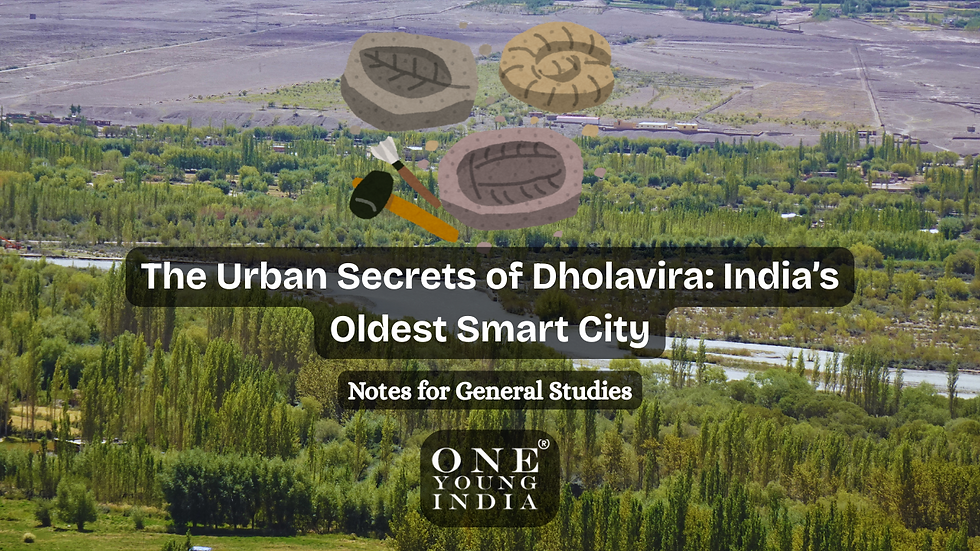Indian Sculpture Schools
- One Young India
- Jan 3, 2022
- 3 min read
Updated: Dec 26, 2022
Indians Sculptures are artistic expressions that reflect cultural characteristics. The Indian subcontinent has a long history of sculptural art. Sculptural remains in various forms- bear witness to the masterly skills of craftsmen that existed and have survived the ages.
Because cultural creation was thought to be a reflection of the divine, saundarya, or aesthetic pleasure, was built into its production and consumption. It's no surprise that the majority of ancient and mediaeval arts arose in a socio-religious context. The artist was a sadhaka, a person who meditated on his creation using a number of prescriptive and ritual texts, rather than an individual genius because art was both an offering and a revelation to him.
Three prominent schools of sculpture developed in India:

Gandhara School
The Gandharan style was a fusion of Hellenistic-Roman, Iranian, and indigenous art forms and techniques. A number of compositional characteristics were adapted from Roman art, while the divine attributes and ornamental components were derived from Hellenistic (Greek) and Iranian traditions, respectively.
The interaction of artistic components was facilitated in large part by the geographic location of the region, which was at the crossroads of cultural exchange. Numerous foreign powers and political configurations, ranging from the Greeks to the Bactrians and Kushana, established themselves in this region. It was also at the centre of commercial activity centred on commerce with the West along the ancient Silk Road.
The bodies are made in the classical tradition with its emphasis on the perfection of the human form. Therefore they are usually shown as youthful and strong.
The majority of the sculptures from this period are Buddhist, while there are also a few Hellenistic sculptures to be seen. The most defining feature of the design is the presence of standing Buddha images.
key Characteristics:
Indo-Greek art
Use of blue-grey sandstone and use of mud and stucco
Mainly Buddhist
Patronised by Kushanas
Mathura School
Adapting the earlier forms of Bharhut-Sanchi art and foreign artistic influences of Bactro-Gandharan art, Mathura art displays the urban and refined preferences of the region's people, patrons, and sculptors, who combined them to produce a widely diffused and influential art style. The sculptures from the Mathura School show a great sense of coherence in terms of their style. The figures feature oval or round-ish faces with open eyes, thick lips, and a pointed nose, and they are presented in a variety of poses with a fleshy full-bodied figure and open eyes.
The art of Mathura is distinguished by the use of mottled red Sikri sandstone, which can be found in the surrounding area and is characteristic of the region.
The most distinctive feature of Mathura art is the plethora or abundance of female figures in various poses carved on railing pillars and Torana uprights engaged in routine activities.
It shows the use of symbolism in the images, the Hindu gods were represented using their avayudhas.
key characteristics:
Indigenously developed
Red sandstone
Depiction of Hinduism, Buddhism and Jainism
Patronised by Kushanas
Amaravati Art
This school developed in the southern part of India, on the banks of river Krishna under the patronage of the Satavahana ruler. The narrative element is predominant, with stories from the life of Buddha and bodhisattva dominating such episodes relating to the Birth, the miracles, Enlightenment and the victory over Mara.
Some Jataka sequences, such as those from the Shibi, Nalagiri and Chhadanta Jatakas, are included.
key characteristics:
Indigenously developed
White marble was used
Mainly Buddhist
Patronised by Satavahanas
Narrative art-Janaka tales
Conclusion/Significance:
The Indian subcontinent's sculptural heritage stretches all the way back to the Neolithic period. However, it has been evolving continuously from the third century B.C. Its evolution in separate places with distinct characteristics is shown in three major schools of art, namely Mathura, Gandhara, and Amaravati. These innovations reached a zenith during the Gupta period. Following the demise of the Gupta Empire, several regional forms of art and architecture developed.
The Pallavas and Cholas (7th-13th centuries A.D.) contributed exquisite bronze sculptures to the history of Indian art.



